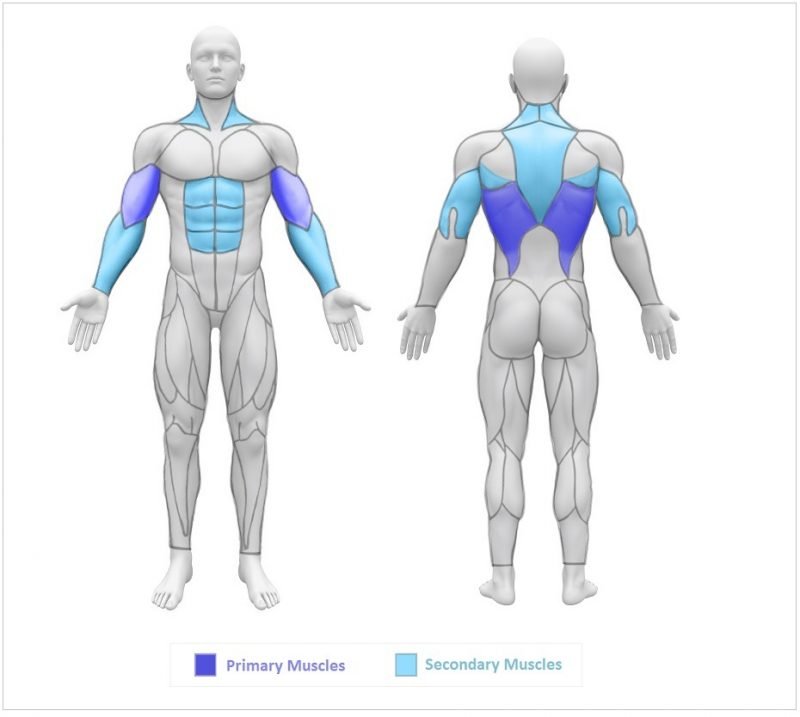Muscle ups are a type of pull-up exercise at an advanced level and is often used in gymnastics and competitive CrossFit training. Muscle-up involves pushing and pulling of the upper body. The perfect muscle-up, whether performed on a ring or a bar, involves three basic movements:
- The pull
- The dip
- The transition
These three steps are dependent on strength. You need to be strong enough to maintain control through the full range of movements and through challenging positions.
Learning more about the benefits of the muscle-up, how it is done, its progression, and about the muscles worked, will help you to maintain beautiful strength.
How To Do Muscle Ups
Although muscle-up is one of the most rewarding exercises, it takes strength and energy to master the techniques, especially if you are a beginner. However, if you have a strict pull-up routine then the muscle-up will be easier to accomplish.
Here are the steps to do a muscle up:
Step 1 – The Pull
Bend your arms Slightlyand keep them shoulder-width apart. Squeeze your thighs together and brace your abs. This will make your body rigid, but it should remain rigid for the entire movement. Pull yourself up and focus on bringing your belly button up (this helps to boost stability and engage your lats and core). Now, look straight ahead and pull until your collarbone touches the bar.
Step 2 – The Dip
Hold on to the bars of the dip station and lift yourself up until your arms are straight. Dip your upper arms below your elbows by slowly lowering yourself and bending both elbows. When your shoulders begin to round forward, pause and push back up to the starting position.
Step 3 – The Transition
Use a low bar or low hanging rings for the transition. It takes a lot of coordination and timing so its good to rehearse the motion.
With your toes curled, lean underneath the bar. Sit your butt muscles (glutes) back on your heels and the bottom of your feet (let the floor support most of your body weight).
With your hands slightly wider than shoulder-width, grab the bar above you. Your elbows should be slightly bent.
Once you have mastered the transition, increase the height of the bar until you must jump to reach it.
Muscle Up Benefits
One important principle of maintaining high-quality muscle-up movement is to make sure that the connection of the body segments that allow the transfer of forces (kinetic chain) has the right requirements to function properly. For instance, the right mobility, stability, and strength. If any of these are lacking, then it will result in weak performance slip and slide nz.
One main muscle-up benefit is that it creates an opportunity for all the body segments to work out at the same time during routine exercises. Which in turn will:
- Improve muscle tone;
- Aid with long-term fat loss;
- Increase flexibility and be more active;
- Improve cardio strength.
Overall, muscle-up involves integrated push and pull movements. These movements assist with total body fitness, developing grip and arm strength, and competitive fitness or CrossFit training; improving performance and skill.
Muscle Ups Progression
1. Strict chin-ups
Before attempting a muscle up it is important to build up strength in the chin-up movement. Because of the power that is needed to push over the bar, it is recommended that you can perform up to eight perfect chin-ups without struggling.
2. Perfect Dipping muscles
After doing the chin up and transition, a good level of strength in the dipping muscles is needed to help raise above the bar. The strength in these muscles will protect the shoulders. It is recommended that you begin with push-ups to build strength if you are unable to do a single dip.
3. Correct Kipping
In bar muscles, it is vital to know how to kip correctly. Kipping requires good body position awareness and basic skills. For example, doing the hollow and arch kipping motion.
These movements help to build kinesthetic awareness. When kipping, keep the legs tight and straight throughout the motion.
4. Box bar muscle up
The box bar muscle-up is the final progression, it is like a jumping pull up where the athlete mimics a kick on a box then jump in the correct position. This helps to build motor memory for athletes.
Muscles Worked

It is important to know which muscles worked while doing a muscle-up. When done the right way, muscle up will develop the following:
- Lats muscles – the flat muscle on the back that stretches out to the sides of the body;
- Biceps- arm muscles;
- Triceps – back of arm muscles
- Trapezius – upper back muscles;
- Deltoids – back muscles; and
- Pecs Muscles – chest muscles.
Conclusion
Muscle up is an exercise that requires strength. It has many rewarding benefits such as helping to maintain a stronger and leaner upper body while improving cardio.
